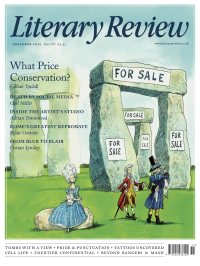Catherine Fletcher
In the Hills of Tuscany
Siena: The Life and Afterlife of a Medieval City
By Jane Stevenson
Apollo 432pp £40
In 1765, the 25-year-old James Boswell found himself in Siena. He enjoyed a few glasses of Montepulciano and the company of the city’s famously fair ladies. One of them, Girolama Piccolomini, fell in love with him. This had not been Boswell’s plan and, as Jane Stevenson explains in her charming history of Siena, he ‘beat a swift retreat’, only to have to deal with Piccolomini’s letters for the next two years.
Boswell was one of many travellers who over the centuries made their way to, and through, Siena’s medieval cityscape. Thanks to its location on the Via Francigena, it was a convenient stopping point on the way to Rome. This route had emerged sometime in the eighth century as an alternative to the ancient Via Aurelia, close to the Tyrrhenian coast, which had been abandoned on account of pirate raids, and to the Via Cassia, which lay on low ground and was subject to flooding. Traders as well as pilgrims were drawn to Siena as a result.
The city’s name probably comes from that of an Etruscan family, but Siena’s citizens, like those of many Italian cities, invented an origin myth to connect the place more closely to the Romans, claiming it was founded by the sons of Remus. Certainly, it was a Roman military outpost, known as Saena Julia, under Emperor Augustus, and its freemen were later granted citizenship. The Bagno Vignoni, Roman thermal baths, long remained in use and were patronised by such late-medieval luminaries as St Catherine of Siena and Lorenzo de’ Medici. By 568, however, the Romans had gone and the Lombards were in charge. The city’s first known bishop was appointed in 650 by a Lombard king.
Stevenson’s beautifully illustrated book whisks us through this past in a highly readable style, ranging over economic history and geography as well as Italian religion, art and culture. We learn of the challenges that Siena’s hilltop location posed so far as access to water was concerned, for example,

Sign Up to our newsletter
Receive free articles, highlights from the archive, news, details of prizes, and much more.@Lit_Review
Follow Literary Review on Twitter
Twitter Feed
Alfred, Lord Tennyson is practically a byword for old-fashioned Victorian grandeur, rarely pictured without a cravat and a serious beard.
Seamus Perry tries to picture him as a younger man.
Seamus Perry - Before the Beard
Seamus Perry: Before the Beard - The Boundless Deep: Young Tennyson, Science, and the Crisis of Belief by Richard Holmes
literaryreview.co.uk
Novelist Muriel Spark had a tongue that could produce both sugar and poison. It’s no surprise, then, that her letters make for a brilliant read.
@claire_harman considers some of the most entertaining.
Claire Harman - Fighting Words
Claire Harman: Fighting Words - The Letters of Muriel Spark, Volume 1: 1944-1963 by Dan Gunn
literaryreview.co.uk
Of all the articles I’ve published in recent years, this is *by far* my favourite.
✍️ On childhood, memory, and the sea - for @Lit_Review :
https://literaryreview.co.uk/flotsam-and-jetsam